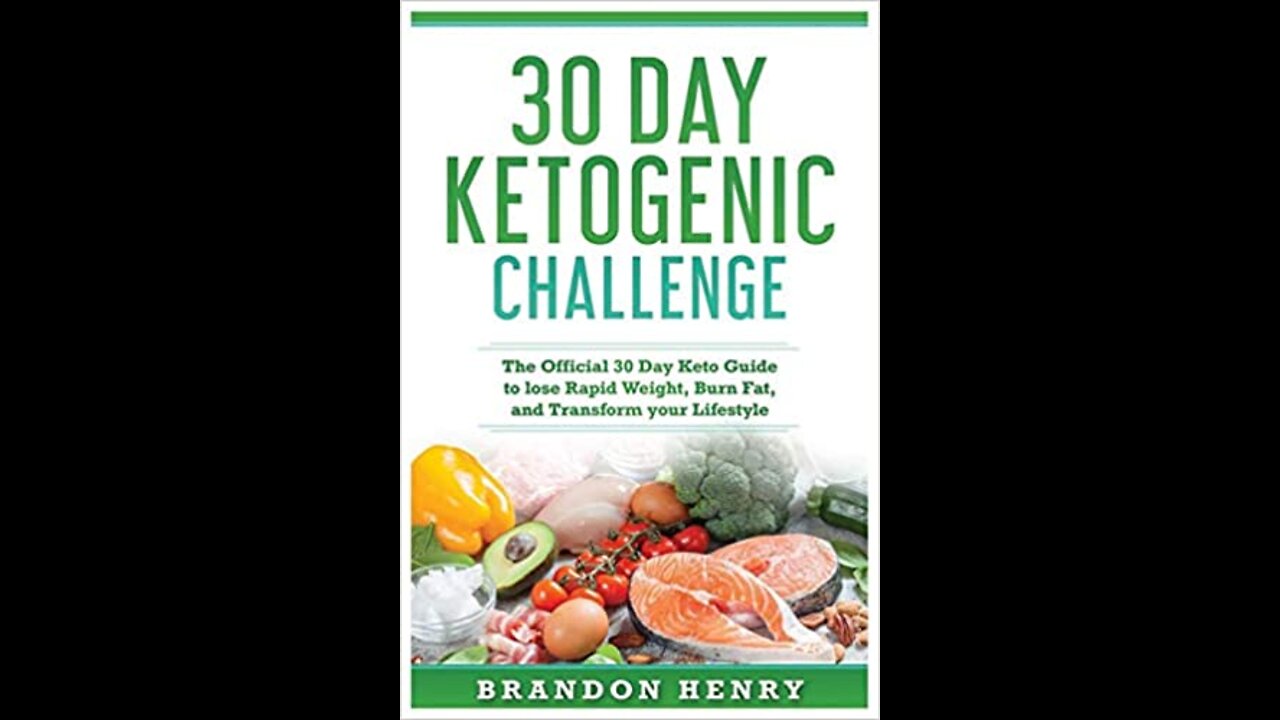Premium Only Content

How to healthy food making training only 30 days &Best tricks
Benefits and cautions of a ketogenic diet.
High fat, ketogenic diets are being used therapeutically for a number of health conditions including Alzheimer’s, epilepsy, cancer and obesity. Low in carbohydrate and high in fat – a ketogenic diet might sound like a new idea, but in fact it was the way our ancestors predominantly ate and some would argue it is how we are designed to eat. Ketosis is where the body burns ketones – derived from fats. For most people, glucose from carbohydrates is the main energy or fuel source for the body.
Our ancestors had little access to sources of sugar – just some fruit and wild honey occasionally. In the autumn, they would have eaten large quantities of fruit, gaining fat to see them through the lean winter months. In the winter, this stored fat supplemented their meagre food intake. When the body switches to using fat as its main form of energy, ketones are created, mainly in the liver.
Using fat as the main fuel is called ketosis and our ancestors would have spent a large proportion of time in ketosis. Today, some populations in the world still consume a largely ketogenic diet. For example, the Inuit’s traditional diet is ketogenic – including nutrient-dense foods obtained from the local environment and comprising largely wild game, marine mammals and fish.
Skip to Key Takeaways
What is a ketogenic diet?
A ketogenic diet is high in fat, moderate in protein and very low in carbohydrate which causes the body to behave in a similar way to periods of limited food availability. The diet is composed of around 65% – 80% fat with carbohydrate and protein constituting the remainder of the intake.
Ketones explained
Between meals, as well as during fasting, starvation and strenuous exercise, when blood glucose levels fall, fatty acids are released from adipose tissue and can be used by most cells as a fuel source (except brain cells which are unable to uptake fatty acids). In the liver some fatty acids are formed into ‘ketone bodies’ – acetoacetate which is then further metabolised to beta-hydroxybutyrate and acetone. Ketone bodies can be used by tissues, including the brain, as a source of fuel.
How much fat, protein and carbohydrate to eat
In order for the body to switch to ketosis, carbohydrate intake needs to be low eg below 50 g per day of net carbs. Some people may achieve mild ketosis at a higher level of carbohydrate than this, others may need to go lower initially, for example, people who are overweight or with metabolic syndrome may need to reduce to below 20 g per day. Net carbs is the amount of carbohydrate minus the fibre.
In Europe food labels generally show net carbs, while in the US labels show total carbs. Net carbs can be calculated by subtracting fibre from total carbs. Carbohydrates should come mainly from vegetables, nuts/seeds, with small portions of fruit such as berries. At 50 g of carbs per day it is still possible to eat 7+ portions of non-starchy vegetables.
There is no restriction on the amount of healthy fats that can be eaten, however once ketosis has been achieved appetite should decrease. It is important to eat plenty of fat to stay in ketosis. So foods such as avocado, olive oil, coconut oil, MCT oil can be eaten liberally. Nuts, seeds, wild oily fish and eggs provide other sources of healthy fats.
Fat phobia may cause people to reduce carbohydrates without increasing fat in the diet, however, a low carb / low fat diet will not achieve sustainable ketosis. On the other hand, beware – eating a high fat diet without restricting carbohydrate sufficiently may lead to weight gain and other health problems.
Medium chain triglyceride (MCT) oil is often used in ketogenic diets. MCTs are a type of fat that can be rapidly and easily converted to ketone bodies in the liver. Coconut oil is a good source of medium chain triglcycerides, eg caprylic acid, but MCT oil is also available and this contains higher concentrations. It can be eaten off the spoon or added to food/smoothies. When adding MCT oil to the diet it is best to start slowly eg one teaspoon per day to avoid any unwanted gastrointestinal side effects.
Protein in foods can be converted by the body to carbohydrates so excessive protein needs to be avoided. Between 0.8 to 1.2 g of protein per kg body weight depending on the level of activity (ie higher level for those who are very active / undertaking strenuous exercise and weight training on most days of the week).
Fasting can be useful to help achieve and maintain ketosis. For example, a 16 hour overnight fast ie skipping breakfast. This would also include avoiding milk etc in drinks and caffeine which stimulates a blood sugar response.
We’d love your comments on this article
It’s easy, just post your questions, comments or feedback below
Benefits of a ketogenic dietpo
The ketogenic diet, if done correctly, can be an ‘anti-inflammatory’ way of eating. When we eat carbohydrate our blood sugar increases and this creates some level of inflammation in the body. Ketogenic diets can:
Lower blood sugar (and thus lower inflammation) and reduce the risk of metabolic syndrome and diseases associated with it
Control appetite – ketosis affects ‘hunger’ hormones and allows us to feel full for longer. In contrast, eating a lot of carbohydrates can have the opposite effect
Help with weight loss
Support memory – research is showing the benefit of ketogenic diets in symptomatic relief from Alzheimer’s and ketosis may have disease-modifying activity through a number of different mechanisms. Increased mental focus can be gained from the diet as ketosis provides a steady flow of ketones to the brain which avoids large spikes in blood sugar levels. The brain’s preferred fuel source is glucose, however, in cognitive decline the brain may struggle to use glucose; this has a dual consequence – the brain is starved of the fuel it needs to function well AND glucose levels in the brain remain high which can cause damage to brain cells. Switching to using ketones as the main source of energy bypasses both these problems and is the therapeutic diet being used by Professor Bredesen in the USA to reverse cognitive decline
Improve physical stamina – ketogenic diets are used by some sportsmen for endurance events
Improve sleep, immunity, anxiety, mood and overall feeling of wellbeing
Epilepsy – The ketogenic diet has long been associated with helping to manage epilepsy. It was discovered to help control symptoms back in the 1920s and was mainly used to help treat children with uncontrolled epilepsy. Controlled trials have shown that the diet can control seizures and more recent results have shown adults as well as children can benefit from it. It can also reduce the need to take anti-epileptic drugs. Specialist dieticians are available to guide patients on the use of this diet.
Is it safe to go on a ketogenic diet?
Some diets which are ketogenic are not recommended, ie diets which are high fat but place little emphasis on the types of fats included (ie they allow processed and inflammatory fats) and diets which encourage protein and fat intake at the expense of vegetables.
The majority of people can safely go on a well-planned ketogenic diet, however, those with serious medical conditions should only undertake this diet under the supervision of a health professional. The diet may not be suitable for those with diabetes, thyroid and liver disease. For example, people with diabetes are at risk of developing a condition called diabetic ketoacidosis which can be fatal. [However, a low carbohydrate diet is recommended for those with diabetes and some people with diabetes may be advised to follow a ketogenic diet with appropriate monitoring and supervision].
For anyone embarking on a ketogenic diet it is recommended that blood monitoring is undertaken at the start and after 2 to 3 months to monitor and check for any adverse changes. Tests to include: Complete blood count, fasting blood sugar, HbA1c, fasting lipid panel, thyroid panel, liver function, kidney function and electrolytes.
Some people can feel unwell in the first few days of changing to this diet – referred to as Keto Flu. This can be helped by eating some salt daily and staying hydrated (urination may increase for a few days).
Increasing fat in the diet and the addition of MCT oil can lead to intestinal symptoms (including diarrhoea), so transition to this new way of eating may be best done slowly, starting with 1 teaspoon of MCT oil per day with food and increasing gradually. If symptoms occur reduce to a lower dose.
Long periods of ketosis can result in loss of muscle and increased fat. Whether this occurs, and how quickly, depends on the person, some endurance athletes use a ketogenic diet very successfully. For the rest of us it may lead to loss of muscle if carried out long-term due to the very low insulin levels. Although in general reducing insulin is one of the benefits of ketosis, one of the actions of insulin is to inhibit gluconeogenesis by the liver (gluconeogenesis is the conversion of protein to glucose); low insulin results in increased gluconeogenesis and muscle breakdown to provide the protein.
Related Cytoplan products:1 milk veganfor children, vegan, raw, paleo-friendly”
Are you looking for delicious healthy milk recipes that satisfy all your cravings while being dairy-free, plant-based and nutritious?
Whether you have read up on conventional dairy products and store-bought nut milks, or are facing health issues such as digestive disorders and bloating, this is the right book for you: all recipes in here are raw, vegan, and highly nutritious!
Making your own milk at home is incredibly cost effective, simple and promotes your health – and the results are so wonderfully delicious that you’ll never look back.http://bit.do/fTvVJ. more....
2 Juicing For Vitality
Every day, every hour, every minute, every second, someone is desperately looking for the most updated, valuable information related to 'Juicing' to better their health regardless of age, gender, ethnicity, or even nationality.
Juicing is HUGE in the Health & Wellness industry which is now ranked the #1 niche and worth a staggering $60 billion today!
So if you’re still not invested in this business, you’re leaving a huge opportunity on the table!
More people are looking online for SOLUTIONS than ever before, a no-brainer will know that the Health niche is a MUST GO for any online business.http://bit.do/fTvVF. more....
3 Vegan Warrior
Once mocked as a cult-like fad trend, veganism has become more popular and mainstream in the United States. Today's vegans come from all walks of life including working mums, college students, teenagers, and professional athletes. The vegan lifestyle garnered the attention of many health enthusiasts worldwide.
With this program, readers will discover effective strategies on how to start their vegan fitness plan.http://bit.do/fTvVE more....
4 Living Paleo Course
INSANELY HIGH CONVERSIONS
REVIEW ARTICLES, BANNERS, POSTS, AND SWIPES
Why Does Living Paleo Convert So Well?
Introduced during the 1970s by a man named Walter Voegtlin, the idea of eating only the foods that were consumed by our ancestors from the Paleolithic era has become immensely popular.
Everyone wants to know more about it. Except there's one problem. Nobody teaches it.
That's where we come in!http://bit.do/fTvVA more...
5. 100% RAW LOVE - the ultimate recipe collection
over 60 recipes for a happy body and mind”
0 % gluten, soy, dairy, sugar, cholesterol or chemicals
100 % flavor, vitamins, minerals, micro-nutrients & tastiness!
Raw food certainly has endless health benefits, which you will notice as soon as you integrate more raw foods into your life.
With simple yet satisfying recipes and easily obtainable ingredients, this book introduces you to delicious dishes which happen to be raw and healthy as a side effect. http://bit.do/fTvVw“ more...
-
 LIVE
LIVE
Due Dissidence
9 hours agoSchmuley TRASHES Shapiro, Maxwell Sings For Pardon, Uhuru Doc Preview - Live From St. Louis!
1,128 watching -
 DVR
DVR
Badlands Media
4 days ago"CODEX 9/11" - Premiering Aug 24th, 6pm ET
186K116 -
 DVR
DVR
Nerdrotic
3 hours ago $0.16 earnedMysteries of 3I/ATLAS | Forbidden Frontier #113
20K1 -
 UPCOMING
UPCOMING
IsaiahLCarter
12 hours agoAPOSTATE RADIO EPISODE 027: Return of the Queen Apostate (Guest: Evan Barker)
39 -
 2:04:21
2:04:21
vivafrei
23 hours agoEp. 278: D.C. Peace Wave! Big Tish & Nipple Judge SPANKED! "Maryland Man" Trafficker FREE & MORE?
57.8K57 -
 LIVE
LIVE
RaikenNight
1 hour agoGoose Goose Duck then I am Building MInis
75 watching -
 11:52
11:52
Exploring With Nug
2 hours ago $0.07 earnedWhat’s Hiding Under This Dallas Lake We Found a Vehicle!
14.6K3 -
 LIVE
LIVE
Phyxicx
3 hours agoRocket League with Rance tonight! - 8/24/2025
34 watching -
 LIVE
LIVE
ManoloCalifas
47 minutes ago🔴 LIVE - DARK SOULS 3 SEAMLESS CO-OP
33 watching -
 2:59:09
2:59:09
Barry Cunningham
8 hours agoBREAKING NEWS: PRESIDENT TRUMP SET TO TAKEOVER CHICAGO AND BOSTON!
33K28